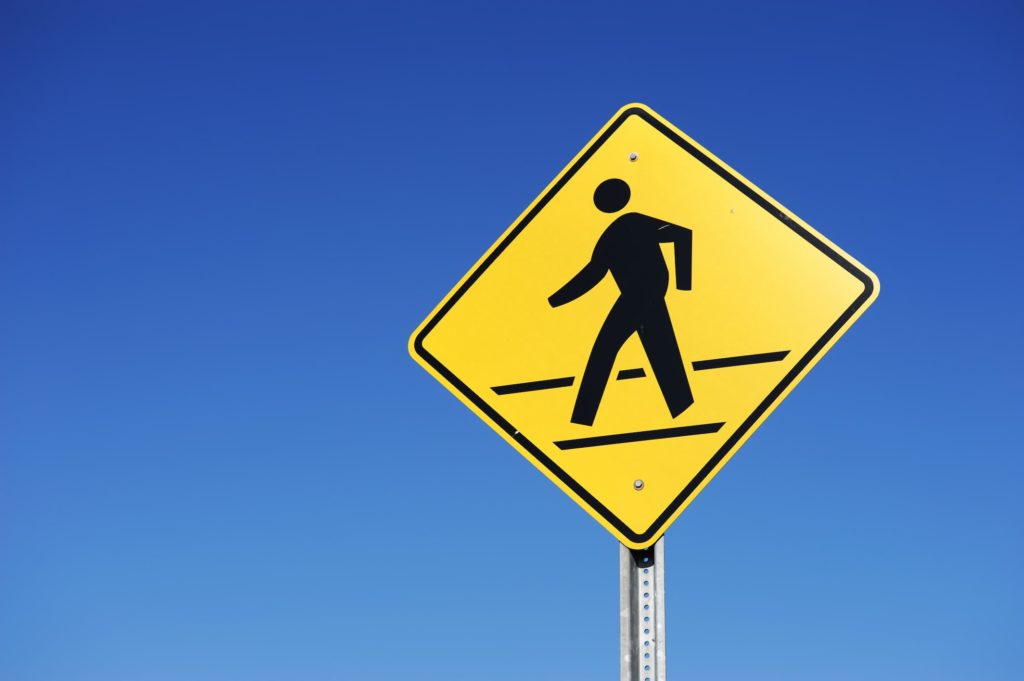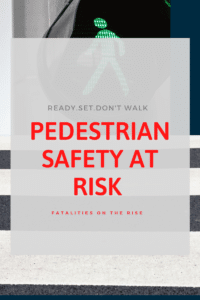

When the danger of walking surpasses that of driving in a vehicle, flying in an airplane, or riding on public transportation lines (trains and buses), there is cause for concern for the on-going rise in pedestrian fatalities. Death statistics from 2017 show that every 88 minutes a pedestrian was struck and killed by a vehicle. While overall vehicular fatalities have been trending down for years, the percentage of “outside the vehicle” fatalities (involving pedestrians, motorcyclists, cyclists, and other non-occupants) has increased from a low of 20% in 1996 to a high of 34% in 2018. Sadly, this represents the greatest number of pedestrian deaths since 1990. Pedestrians are at a high-risk level of being put in danger, even when obeying proper traffic laws and controls.
The major contributing factors to the varying degrees of pedestrian injuries include vehicle type, vehicle speed, distractions, and time of day. Pedestrians struck by light trucks and SUVs (vehicle types with elevated and narrow front ends) are more likely to sustain injuries from impact points aligning directly with their upper body (head and chest), found from a recent study conducted by the Insurance Institute for Highway Safety. Speed can increase a pedestrian’s mortality as shown in a recent AAA Foundation for Traffic Safety study. The study showed that a person’s risk of dying from being hit by a vehicle going 23 mph is to 10 percent while being hit by a vehicle going 50 mph increases that risk of fatality to a startling 75 percent. Automobile companies have upgraded their various 2019 vehicle models to include Driving Safety Assist Technologies, which work in tandem with cameras and radar to aid in pedestrian detection. The capability of these systems is intended to sense when a pedestrian is in the vehicle’s path, alerting the driver early so as to increase response time, in order to lessen the severity or completely being able to avoid a collision. These detection technologies are only intended to be used as complementary support rather than being used as a direct replacement for driver awareness, with testing completed by the ARC (Automobile Club of Southern California’s Automotive Research Center)/AAA. This testing affirmed that pedestrian detection on these vehicles works at its peak during the day when a pedestrian is positioned directly in front of it while traveling at 20 mph. Also, distractions like those created by smartphones – texting, in-ability to hear surroundings with earbuds inserted, and social apps – have proven to increase the chance for harm to both drivers and pedestrians. The most dangerous factor is the time of day for pedestrians, where 75 percent of fatalities occur during evening hours.
At a time when millions of drivers and pedestrians are co-sharing transit routes and roads, it is imperative to produce viable transportation models that put efficiency and overall safety on the forefront. Fortunately, there’s evidence to support a significant reduction of injuries and fatalities by municipalities taking the initiatives to implement intersection safety strategies. Efforts made in-conjunction with traffic and transportation engineers are helping to make these strategies a success by providing design solutions for projects such as highway infrastructures and access points, street layouts, bridge infrastructures, signals, sidewalks, and bike lane placements; all of which can aid in lowering pedestrian risks and promoting safety. In changing signal designs, an example of this safety implementation is to offset the timing interval for the green “walk” signal to display before a driver’s green signal, creating a safer pedestrian movement and allowing more visibility for both parties. Focusing resources on stabilizing areas with hot spot crash sites and high-risk pedestrian crossing points is a major undertaking as traffic engineers strive to keep an emphasis on resolving public safety issues. States, local highway commissions, and communities are continuing to work together to develop plausible strategies to reduce pedestrian fatalities to zero. In aiding the efforts, all pedestrians and motorists need to also practice safety-first thinking: namely minimizing the distraction of mobile devices and headphones, obeying all traffic signals, using caution when walking at night, and always taking the time to look both ways and utilize the access of crosswalks and other traffic control features; in helping to achieve the goal of keeping pedestrians and drivers risk-free on all roadways.
References:
AAA, Inc., “AAA NewsRoom,” 2019. [Online]. Available: https://www.aaa.com/AAA/common/aar/files/Research-Report-Pedestrian-Detection.pdf.
National Center for Statistics and Analysis. (2019, March). Pedestrians: 2017 data. (Traffic Safety Facts. Report No. DOT HS 812 681). Washington, DC: National Highway Traffic Safety Administration.
National Center for Statistics and Analysis. (2019, October). 2018 fatal motor vehicle crashes: Overview. (Traffic Safety Facts Research Note. Report No. DOT HS 812 826). Washington, DC: National Highway Traffic Safety Administration
Tefft, B.C.
(2011). Impact Speed and a Pedestrian’s Risk of Severe Injury or Death. AAA Foundation for Traffic Safety.

